 полная версия
полная версияNature's Teachings
This is, as we all know, a token of high civilisation, and even in the ancient times the hanging gardens of Babylon were reckoned as the greatest wonders of that great city, the then mistress of the world.
No savage ever dreamed of such a thing as a pleasure garden, nor could appreciate it if he saw it. Yet there are birds which far surpass the savage in this respect, and which build recreation grounds for the sole purpose of amusement.
These are the well-known Bower-birds of Australia, which I sincerely hope may not be extirpated by the white man, as has been the case with so many creatures, including the aborigines of Tasmania themselves.
The Bower-birds, which are distantly related to our thrush and blackbird, but are about as large as jackdaws, have a curious habit of building arched bowers quite independent of their nests.
The shape of one of these bowers is shown in the accompanying illustration.
The bird first weaves a sort of platform of flexible sticks, and then fastens into them a number of other sticks, so set that they form a sort of arched gallery. Through this gallery the birds love to run, and they invariably decorate the ends with anything pretty that they can pick up, such as feathers, coloured stones, shells, ornaments, and the like. So well is this proclivity known, that whenever any one who is living in the Bush loses any small piece of property, such as a pencil-case or watch-key, or even a tobacco-pipe, he always goes to the Bower-bird’s pleasure garden, and mostly discovers the lost property.
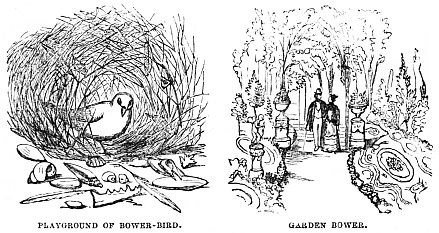
At the Zoological Gardens these Bower-birds have long lived, and it is a most interesting sight to watch them weaving their platforms, raising the bowers over them, and then keep running in at one end and out at the other, like children at play, and with their burnished plumage gleaming in the sunbeams.
The right-hand figure simply depicts a modern pleasure garden, and needs no description.
CHAPTER IX.
ARTIFICIAL WARMTH.—RING AND STAPLE.—THE FAN
Various Modes of warming Houses.—The Fire of the American Indian and the Kafir.—The Oil-lamp of the Esquimaux.—The open Fireplace and Chimney Stoves.—The laminated Stove and its Powers.—Gills of the Lobster, Crab, and various Fishes.—Mode in which the Gills act.—Why Fishes lie with their Heads against the Stream.—Drowning a Fish.—The Ring and Staple, and their various Uses.—Head-bones of the Fishing-frog or Angler-fish.—The Fan and its Modifications.—Japanese and Chinese Fans.—The Feather Fan.—The Palm-leaf.—Indian Fans.—The Hive Bee and its Wings.—Fans of the Essequibo and South Sea Islanders.—The Fan Fire-guard.—Antennæ of the Cockchafer.—Burial.—Various Modes of disposing of the Dead.—Ordinary Habits of dying Animals.—Dead Insects.—The Funeral-ant and its wonderful Habits.
Artificial WarmthPASSING from the direct to the indirect comforts of a household, we will take Artificial Warmth.
The savage, as a matter of necessity, makes a fire in the middle of his hut, and lets the smoke have its own way. Sometimes, as is the case with the North American Indians, the top of the conical hut is open, and the whole edifice is a single chimney of large dimensions, something like the “chimney-corner” of past days, which only survives in such places as the New Forest.
Then there are the various Kafir tribes of Southern Africa. They have no aperture in their huts except the tiny doorway, which can only be entered on hands and knees. But they must have their fire. No argument can persuade them that they had better make their fire and cook their food outside the hut. So the wood-smoke fills the hut, coats it with a lining of soot, and gets out as it can through the sticks and withes of which the simple edifice is built.
As a contrast, we have the oil-lamp of Esquimaux-land, where there is no provision for ventilation, where the snow-houses are tightly closed and crammed with inhabitants, and where no one seems to need fresh air.
The next step in civilisation is to construct a tube for the purpose of carrying off the smoke, such as we know by the name of chimney or flue, and to place the fire within it. We English people have an ingrained love for the open fireplace, and though it really is an expensive arrangement, it is worth the cost. Granting that it carries much of the heat into the chimney instead of throwing it into the room, it has at least the advantage of acting as a ventilator, of ejecting air which has been rendered poisonous by respiration, and drawing a fresh supply from the outer atmosphere.
In some parts of the world, especially in Germany and the United States, the place of the open fire is taken by closed stoves, without any ventilation whatever, much to the discomfiture of ordinary Englishmen. Still, there are buildings, such as public halls and places of worship, in which open fireplaces are wholly impracticable, and where it is, therefore, necessary to make use of the stove.
It need hardly be said that in such cases the chief object is to procure the greatest amount of heat with the least expenditure of fuel, and that object seems to be best attained by the Laminated Stove shown on the right hand of the illustration.
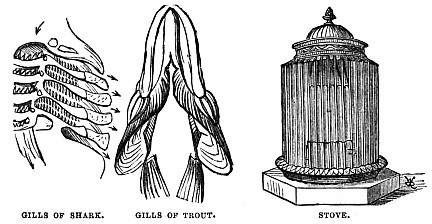
In this stove, the outer surface, instead of being plain, is divided into a number of perpendicular plates, which are heated by the contained fire, and expose a very large surface of hot metal to the air. Thus the heat, instead of being wasted by being drawn through the flue or chimney, is thrown into the room, and keeps up a perpetual supply of warm air.
That the invention of this stove is an ingenious one nobody can deny. But Nature has been long in advance of Art in the way of exposing as large a surface as possible with the least expenditure of space.
Very familiar examples of this structure may be found in the many creatures which inhabit the waters and breathe by means of gills, which extract the oxygen of the water.
Take, for example, a Lobster or a Crab, open it, and look at the white, pointed, uneatable objects which are popularly called “ladies’ fingers.” These are the gills, or breathing apparatus, and their structure is really wonderful. They are composed of innumerable laminæ, or very thin plates, covered with an exceedingly fine membrane, and placed closely side by side, but with sufficient distance between them to allow the water to percolate the whole structure.
With the aid of an ordinary pocket lens the observer may make out a most wonderful system of blood-vessels, which permeate every one of the myriad laminæ, and which extract the life-giving oxygen from the water as it passes between them.
Then, to pass to animals of a higher order, take the gills of fishes. Any fish will do, provided that it be fresh, and, if it can be examined immediately after death, so much the better. Taking things reciprocally, the gills of the fish and the laminæ of the stove, are identical in principle, namely, the exposure of much surface with little loss of space.
If possible, the observer should inject the blood-vessels of the gills with the conventional crimson and blue wax, showing the currents of the arterial and venous blood. Each lamina forms a most wondrous object, and may be gazed upon for weeks with increasing admiration.
Every one who has watched the habits of fishes must have noticed that in running waters they always have their heads against the stream, and do not greatly care about shifting their positions.
In still waters, especially such as those of the ordinary glass aquaria, the fish are perpetually on the move, whereas in such a river as the Dove of Derbyshire, and even the Darenth of Kent, large trout may be seen almost motionless, but invariably with their heads directed up the stream.
The reason is evident enough. As long as the fish lies with its head up the stream the water flows through its gills, and enables it to breathe. Were the passage of the water stopped, the fish would be drowned. Consequently, all good anglers, when they hook a fish which is worth taking, keep its head down the stream, prevent the water from washing over its gills, and consequently render it so weak by deprivation of oxygen, that it becomes an easy prey, and is rendered subservient to a line of a single hair. Let the fish breathe, and a single struggle would smash a line of treble the strength. But keep it from breathing by directing its head down the stream, and it rapidly loses all strength, and can be directed into the landing-net, or brought within the scope of the gaff, without a chance of escape.
I need hardly remark that on the right-hand side of the illustration is shown a Laminated Stove, and that on the left are drawings of the gills of the Shark tribe and the common Trout. If the reader would really like to look into the subject for himself, I should suggest the purchase of a cod’s head and shoulders and a lobster. The breathing apparatus can be removed from each for examination, and the remainder will serve as a first course for dinner.
Ring and StapleHumble, and apparently insignificant, as the principle of the Ring and Staple may be, we owe no small amount of our domestic comfort to it. It meets us in all kinds of ways, in the hinges of our boxes, in the padlocks of our doors, in the innside fastenings for our horses, in the seaside fastenings for ships’ cables, and in a thousand other ways too many to enumerate.
On the right-hand side of the next illustration is shown the Ring and Staple as used for the purpose of mooring ships and boats, it being absolutely necessary that the machinery, simple as it is, must be capable of working in any direction, and with some latitude as to the extent.
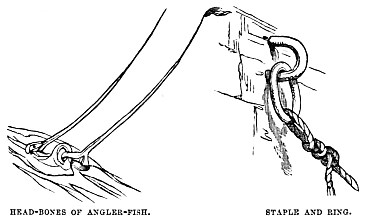
On the left hand are shown two of the wonderful bones which are found in the head of the Fishing-frog or Angler-fish (Lophius), and which serve as decoys, by means of which the smaller fish are entrapped into the vast jaws of the Angler-fish.
It is clearly necessary that these singular appendages should be capable of movement in every direction, and this object is attained by the structure which is here shown, and which is almost equal to the ball-and-socket joint for its freedom of movement. It will even allow of partial rotation, so as to cause the little strip of skin at its end to assume the aspect of a living worm, and entice the smaller fish into the jaws of the dread trap that lies open before them.
A figure of this fish may be seen on page 92.
The FanExcept in permanently cold countries, a Fan of some kind seems to be an absolute necessity. Sometimes, as in the greater part of Europe, it is used only by the softer sex. The harder sex would often be only too glad to use it if they dared, and the same observation is equally true with regard to the parasol.
But, in such lands as Japan and China, the Fan is an absolute necessity of existence. Men, women, and children alike carry their Fan, and almost perpetually use it. I remember, when the troupe of Japanese acrobats were in England, that one of them exhibited the national use of the Fan in an excessively ludicrous manner.
One of his comrades ascended to the roof of a lofty building, hung by his legs to one of the rafters, and held in his hands a bamboo pole which was twenty feet long. Another Japanese also ascended, climbed over his comrade, and settled on the bamboo pole, to which he clung only by the clasp of his bare feet. Suddenly he slipped down the pole, stopped himself when within a few inches of the end, squatted there with perfect unconcern, though at least forty feet from the ground, took his fan from the back of his neck, and fanned himself while gravely surveying the startled audience.
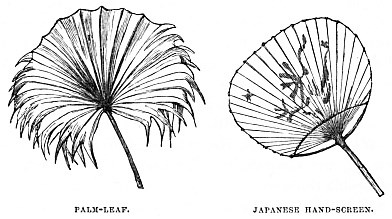
Perhaps some of my readers may remember Chang, the Chinese giant, who, by the way, in private life was a polished gentleman. He was never without his fan, always keeping it fluttering gently with an ease only to be acquired by a lifelong practice, and I really think that if he had been deprived of it he would have been seriously ill. How he slept without it is a wonder, for in his own house the fan was incessantly in motion, and was worked with apparent unconsciousness on his part.
I have often wished that in our country the ladies would manage their fans in the same quiet way when they are in a church or a concert-room, for the perpetual rattle of the joints is enough to distract any preacher or conductor, and very often does so.
As to the shape of the Fan, it varies greatly according to the country, but it may almost invariably be traced to some familiar object.
There is, for example, the common Japanese Fan or Screen, which is avowedly made on the model of the Palm-leaf, the ribs of the leaf being represented by split portions of a bamboo stem. The right-hand figure in the preceding illustration is taken from one of the common sixpenny Japanese fans that may be seen in many shop-windows.
There are exactly sixty ribs in the fan, all produced by splitting the bamboo into strips, kept in their place by a slight rod of the same material, and covered with two pieces of thin printed paper. Seeing that the original cost cannot be more than a penny, it is wonderful how such articles can be produced, and give a living to the makers.
The reader will observe that the shape of the Japanese Fan is almost exactly that of the Palm-leaf, with the exception of the jagged edges, and a better pattern could not be found. Then there are many Indian Fans framed on the same model, but which revolve on their handles, and are swung slowly round and round by the servants before the guests, and thus become miniature punkahs.
Here, again, we may find a parallel in Nature. The common hive bee ventilates its dwelling by using its wings in lieu of fans. When the hive is really in want of fresh air, the bees set to work, and wave their wings backwards and forwards for a considerable time, so that they necessarily expel the foul air from the interior of the hive, and create a partial vacuum, which can only be filled by fresh air from without.
Fans of very similar shape are in use among the South Sea Islanders and the inhabitants of the Essequibo district. They are often used as bellows when a fire has to be raised, but their primary object is to be employed as fans.
Next we come to those fans which are made of flattened sticks, which move on a pivot. This is, indeed, the ordinary form of the fan at the present day, the sticks being sometimes wide enough to constitute the entire fan, but mostly being connected with a sort of lining made with silk, paper, or feathers. Such fans as these can be moved on their pivots, so as to occupy a comparatively small space; and the same can be said of the modern fender-guards, which can be folded up when the room is unoccupied, and which form an effectual protection against the danger of ladies’ dresses coming in contact with the fire.
Examples of such a screen, and two fans, are given on the right hand of the accompanying illustration.
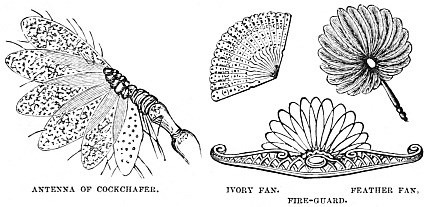
On the left hand is shown one of the natural objects from which the fans, &c., might well have derived their origin. It is one of the antennæ—or horns, as they are popularly called—of the common Cockchafer. The end of this antenna is composed of a number of flat plates, which work on a pivot exactly like the sticks of a fan, and, like those sticks, can be folded into a wonderfully small compass, or opened out into a fan-like shape.
BurialLast scene of all.
I do not think that it matters very much to one who has “shuffled off this mortal coil” what becomes of the coil in which he had been imprisoned. Whether the abandoned body be buried in the earth, or sunk in the sea, or devoured by wild beasts, or consumed by fire, signifies nothing to him, though it may signify much to his surviving friends.
As a rule, the animals, of whatever kind they may be, contrive to dispose of their mortal remains in some mysterious manner, so that not a vestige of them is to be found. Take, for example, the domestic cat, and see how few bodies are found of cats which have died natural deaths.
For instance, there was my own cat “Pret,” who lost his life from the bites of rats. He was blind, and so lamed that he could scarcely crawl. Yet, on the day of his death, he three times escaped from his comfortable bed in front of the fire, dragged himself through a hedge, down a steep bank, across a road, up another bank, through a crevice in a park fence, and curled himself up to die under a blackberry-bush.
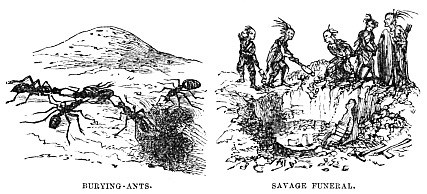
Perhaps it was mistaken kindness on my part, and I should have acted better if I had left him to die in peace. But, though I carried him back three times, and though he was quite unable to see, he contrived to slip out of the house, and to find the same spot for his last resting-place on this earth.
I have heard that some cats have been known to bury their young, and Dr. J. Brown tells a most touching story of a dog that committed her dead puppy to the river.
But as to Insects, until a few years ago, no one ever dreamed that the principle of burial could be found among them. What millions of insects die in every year, and how seldom is a dead insect found! Flies, gnats, and the smaller insects might escape observation, but the large moths, butterflies, beetles, dragon-flies, &c., are scarcely ever found dead.
In my own neighbourhood, for example, the Stag-beetle, nearly the largest and most conspicuous of British insects, swarms to an almost unpleasant degree, especially in the summer evenings.
Yet I have never found a dead Stag-beetle that had not been killed by violence. What becomes of the bodies of the countless millions of creatures that annually pass into their other world is a problem which at present no one seems to be able to solve.
Still, there are instances where even insects are known to bury their dead, and I scarcely need say that they are to be found among the Ants.
The story is a very curious one, and is narrated at length in the Journal of the Linnæan Society, vol. v. p. 217.
It happened that a lady found that her little boy was being stung by ants, and she at once killed them and threw their dead bodies away. After some time a number of ants came out of their nest, formed a procession as regularly organized as that of any undertaker’s funeral, dug graves for each dead ant, laid the body in it, and covered it up again with earth.
They carried their organization to such an extent that they even had relays of bearers. But the strangest part of the story is that several worker ants would not assist in the funereal ceremonies. The soldiers at once set on them, killed them, and tumbled them all promiscuously into a common grave.
Such scenes were repeatedly witnessed by the lady, a Mrs. Hutton, who wrote the account while she was living in New South Wales.
CHAPTER X.
WATER, AND MEANS OF PROCURING IT
The Necessity of Water to Man.—Composition of the Human Body.—Natural and Artificial Distillation.—The Traveller’s Tree.—Pitcher-plants and Monkey-pots.—Stomach of the Camel, and its Analogy to the Honey-comb.—Dewdrops.—Use of the Still at Sea.—Perspiration and its cooling Properties.—The Turkish Bath.—Perfume and Ether Spray.—Condenser of the Low-pressure Steam-engine.—The Dry and Wet Bulb Thermometer.—Ice produced in a red-hot Vessel.—Power of Water.—How Fountains are made.—Modern System of Hydrants.—Hydraulic Mining.—The Victoria and Niagara Falls.—Artesian Wells.—The Norton Tube, &c., in Abyssinia.—The Water-ram and Spout-hole.
IT has often been remarked that man can live a comparatively long time without solid food, providing that he can only obtain water, of which the chief bulk of the human body is made. Dying by thirst is a horribly painful death, but, according to Mr. Mills, the ill-fated Australian traveller, “starvation on nardoo (an innutritious plant) is by no means unpleasant, but from the weakness one feels, and the utter inability to move one’s self.”
Those who have been shipwrecked, and unable to obtain fresh water, have always found that the tortures of thirst were infinitely harder to endure than those of hunger; and the reader will probably remember that those who perished in the Black Hole of Calcutta owed their deaths chiefly to thirst, their bodies being exhausted of moisture by the heat of the room, and no fresh supply attainable.
Civilisation especially shows itself in the way in which water is brought within the reach of every one, even in the most crowded of cities. The reader may probably call to mind the wonderful aqueducts of ancient Rome, the gigantic remains of which still exist. Then, as to our own country, we are all practically acquainted with some water company, by which the water, more or less purified, is brought into our houses, and can be obtained by the mere turning of a tap.
Yet all this ingenuity is but a following of natural prototypes, as will presently be seen; and even the familiar Water-tank, as shown at the right hand of the illustration, has been anticipated by Nature.
On the left hand of the illustration there are three examples of natural water-tanks, two belonging to the vegetable, and one to the animal kingdom.
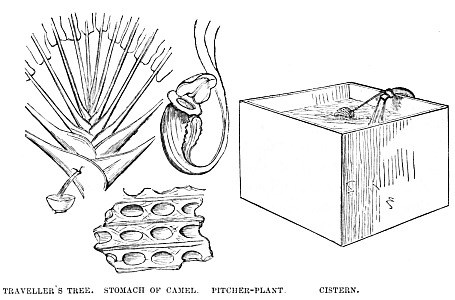
That on the extreme left, with a number of radiations, represents a portion of a Madagascar palm, popularly called the Traveller’s Tree. Having very large leaves, arranged in the manner there shown, the Traveller’s Tree condenses the nightly dews, and allows them to trickle down into the hollows of the leaf-stems.
There the water remains, out of the reach of sunbeams or wind, and if a traveller happens to be thirsty, all he has to do is to pierce the base of one of these gigantic leaves, and out rushes a stream of the purest water, as is shown in the illustration.
Next to the Traveller’s Tree is shown one of those extraordinary vegetables called Pitcher-plants, from the strange conformation of the leaves. They inhabit Borneo, Siam, and other hot countries. In these remarkable plants some of the leaves are developed into suitable pitchers, with hinged lids, exactly like our hot-water jugs. They serve, however, a different office, and contain cold water which the plant has distilled from the dew.
As the monkeys are in the habit of resorting to these plants when thirsty, they are sometimes called Monkey-pots. There is an admirable account of the Pitcher-plants and their development in the Transactions of the Linnæan Society, vol. xxii. part iv. The scientific name of those plants is Nepenthes.
Below the vegetable comes a rather celebrated animal cistern, namely, a portion of one of the stomachs of a Camel.
It exactly corresponds with that part of an ox which butchers call “honey-comb tripe,” and consists of a multitude of cells, which can be closed or opened at will. When the camel takes in its provision of water, it can treat this portion of the stomach much as the hive bee treats the honey-bag, and fill its cells with water.
By degrees, when it finds the necessity for moisture, it can squeeze the water out of these receptacles into the digestive portion of the interior, and so can sustain life for a wonderfully long time under conditions which would kill any other animal. I may remark, by the way, that the amount which a camel can drink, and the length of time through which it can endure its desert life, have been much exaggerated. There is another point to be considered, namely, the curious resemblance between these cells and the honey-comb of the hive bee. Every one knows that honey, no matter how tightly closed, will crystallize and lose its best qualities if kept in jars, whereas if it be allowed to remain in the waxen comb, where it is divided into very small portions, it will remain good for years.
It is just the same with the cells of the camel’s stomach, they being able to preserve water in a pure state by distributing it among a number of small cells, which can be opened or closed at will.






